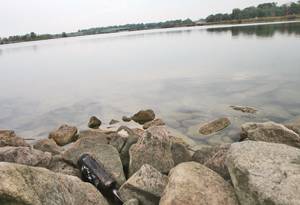Ada Hayden water quality threatened

A bottle sits on the north shore of Ada Hayden Park’s lake on Grand Ave. this Monday. Poor water quality in Ada Hayden Park has become an issue during talks of closing the park down. Photo: Will Johnson/Iowa State Daily
September 23, 2008
The wetlands designed to filter pollutants from Ada Hayden lake may be doing more harm than good.
On Sept. 16, a panel of experts presented their studies on Ada Hayden Lake to city council members.
“[The meeting] was an attempt to answer some of the scientific questions of Ada Hayden,” Ames Mayor Ann Campbell said.
The city council members now have to decide on whether to annex the land north of the lake or leave it as it is. A developer is currently waiting approval from the city to annex the land for housing development.
“The alternative that has been put before us and that was highly recommended by several of the experts there was to annex the land and allow a very controlled development on it,” Campbell said. “It’s totally dependent upon what the city council decides to do.”
Timothy Stewart, assistant professor of natural resource ecology and management, discussed data on his studies of the three wetland areas of Ada Hayden. The wetlands were put in five years ago to receive stream flow off the surrounding urban and agriculture landscape to prevent runoff from entering the lake and to help the water quality of Ada Hayden, Stewart said. However, he said some of the wetlands are not acting as an alleviation of pollution, but rather a supply of pollution to the lake.
“If we want wetlands to remove pollutants, we need plants and invertebrates,” Stewart said. “Otherwise we’ve got sediments suspended in the water, and they are leaving the wetlands.”
Professor emeritus of animal ecology Erwin Klaas said Stewart knew of an area of Ada Hayden that has trouble with sediments leaving the wetlands. He said carp are stirring up sediment that then flows from the wetlands into the lake.
“There’s one set of wetlands on the south side that drains a large area that is all developed,” Klaas said. “These wetlands have trouble with carp. The carp stir up the bottom sediment and that re-suspends these nutrients into the water.”
Klass said in all developing urban or agricultural land, “adequate pollution control should be put in place to regulate stormwater runoff as well as nutrients.”
Chris Rehmann, associate professor of civil, construction and environmental engineering, and some of his students have been studying the mixing of water in Ada Hayden.
He said his part in the meeting was to explain to the city council members how the lake operates in terms of physics, such as wind strength and water temperature. But Rehmann also expressed concern with the quality of the water.
“As a citizen [of Ames], I’d like to keep Ada Hayden as nice as possible. First, it’s a backup water supply, but second, it’s one of the nicer parks of Ames,” Rehmann said.
















